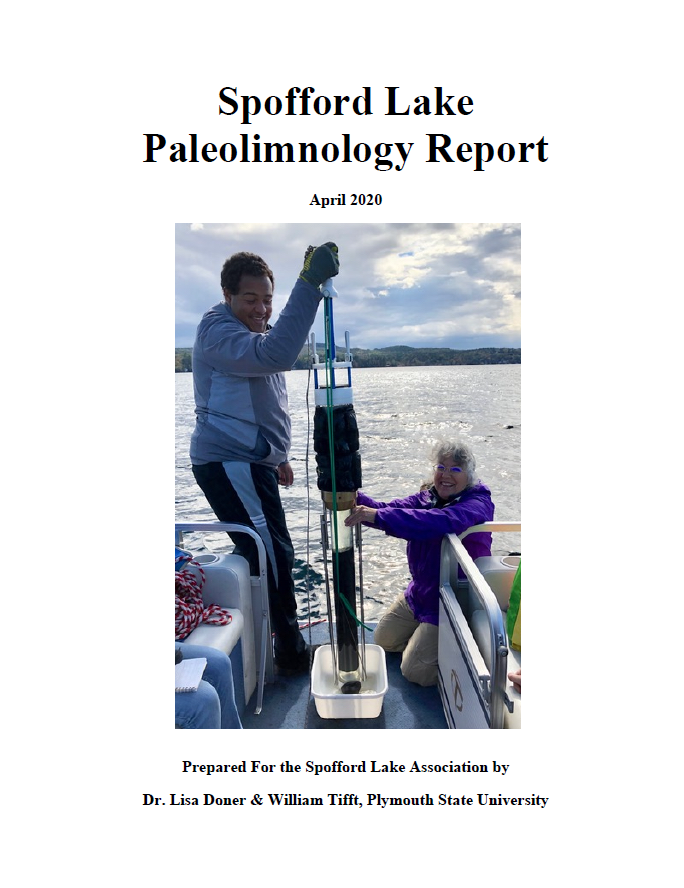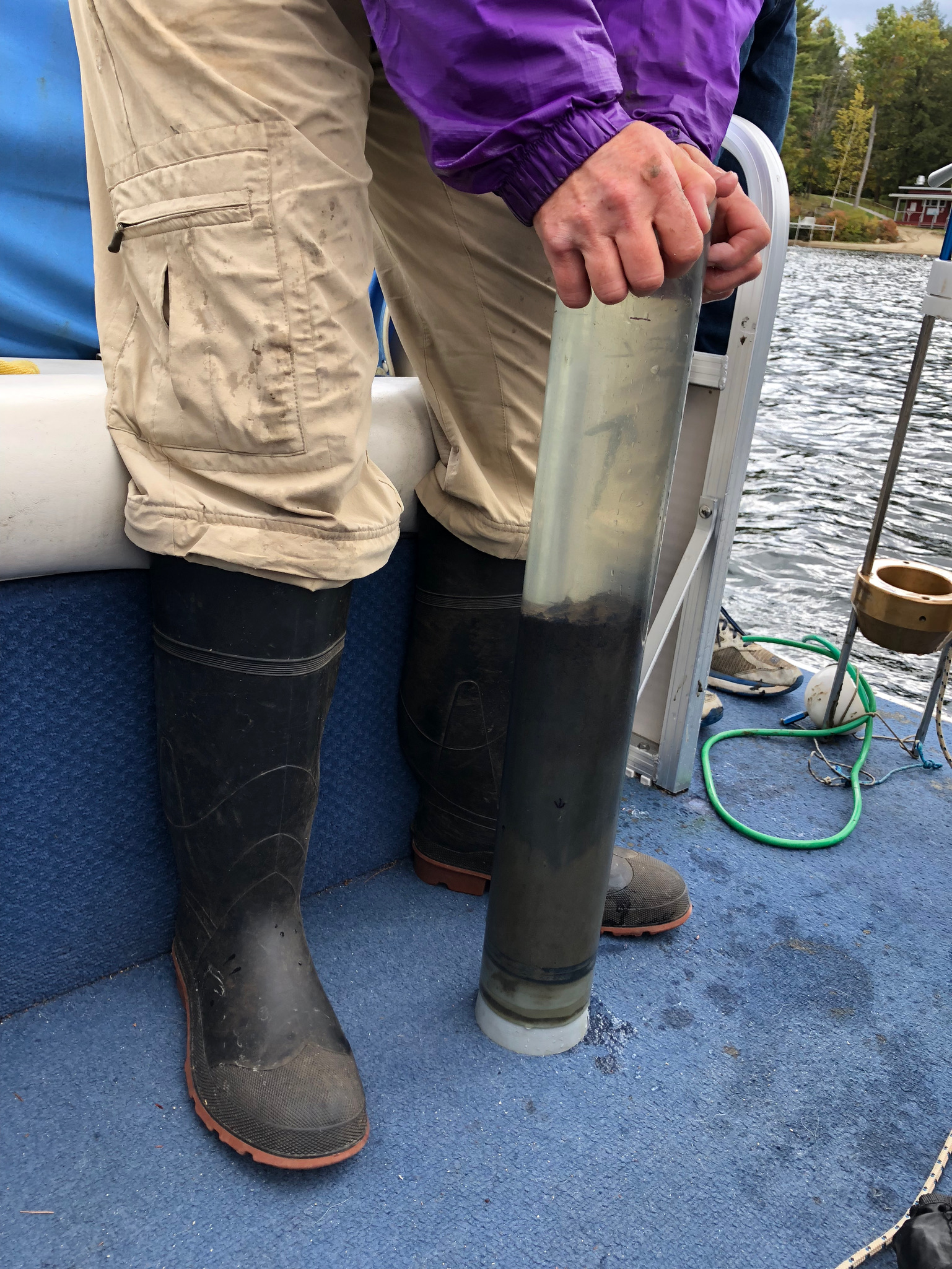Sediment Sampling & Analysis
What are the results of Sediment Sampling 2.0? Watch the video of Laura Diemer's November 19, 2025 presentation. In a nutshell, she advises more targeted testing and more robust reporting on cyanobacteria, a key indicator of lake health. Remedial action is not warranted at this time nor possible as the SLA has insufficient data to meet the State's permitting process for, e.g., an alum treatment or an aeration system. Why was a second sediment sampling undertaken? Sediment sampling 2.0, specifically for phosphorous, was conducted on August 12, 2025 by a field team from FB Environmental , i.e., Laura Diemer and Amelia Wallis and two SLA volunteers. Its purpose was specific to identifying the mass of phosphorous in the first 4-6 inches of the Lake bottom. Twelve locations were sampled across Spofford Lake, including the deep spot. Armed with a 25+ pound gravity corer, a heavy tube that plunges into the lakebed to collect layers of sediment, the team gathered samples along major flow lines and at varying depths within Spofford Lake. These samples were sent to the highly regarded University of Wisconsin Stout Lab for analysis of the different fractions of phosphorous, allowing for an estimate of the total mass of phosphorus stored in the lakebed and, importantly, the portion of phosphorus that could be released into the water column when deep waters lose oxygen, a condition which occurs each summer in Spofford. Our August 1 report (check the Archive) reported that the data coming from the continuous monitoring buoy located over the deep spot shows prolonged periods of low dissolved oxygen (DO) at 14 and 16 meters. When bottom waters go anoxic (oxygen-free), sediments release phosphorus, a condition called “internal loading,” which can fuel excessive toxic algae and plant growth. The August 12 samples, along with other information, will assist in determining the scope of any remedial action. Why did the SLA have a core sediment analysis done in 2018? The Core Sediment Analysis report, i.e., the Paleolimnology report, was done to meet the first objective and first action item of the Watershed Management Plan, which were respectively to "investigate the cause of low dissolved oxygen in Spofford Lake" and “determine the cause and extent of dissolved oxygen impairment and inform any adjustments to the water quality objectives." Taken together, the Watershed Management Plan and the Core Sediment Analysis (2020) form foundational pillars for maintaining and improving Spofford Lake’s water quality and informing any remedial actions. |
What is the Report's goal? "To identify probable causes for deteriorating water quality conditions as described in the Spofford Lake watershed management plan." Who authored the Report and when? The Report was joint effort of Lisa Doner PhD and William Tifft and Plymouth State University's Sedimentology Lab. Samples were taken in October 2018 and the report issued in April 2020. The Report was paid for by donations from Spofford Lake Association members. What are the Report's conclusions? The report concludes that decaying organic material eroded from the shoreline is the cause of the Lake becoming ‘impaired’ for aquatic life. See pages 15 and 16 for these conclusions and the preceding pages for the underlying science. The report notes that after 1910 and after 1980, there has been more organic material in the accumulating sediments, and the amount of organic material reaching the lake bottom exceeds that of any other period since 1700. Since 1980, sediment characteristics have changed more than any other time in the past several hundred years and that the increased organic deposits are associated with increases in oxygen impairment in the (Lake's) deep basin. It goes on to note that these time frames coincide with periods of shoreline and watershed development, higher damming of the Lake, and the advent of more powerful watercraft. Why is this important to me, a homeowner or a Spofford Lake lover? Oxygen impairment is an important by-product of a nutrient rich plant environment which fosters, among other plants, algae and cyanobacteria blooms. Oxygen impaired environments are harmful to some fish species, particularly game fish such as trout and salmon. As these fish seek colder, deeper water in summer, there is too little oxygen to reproduce and survive. A robust fish population is one factor in a healthy lake, which itself is an underpinning of strong property values and a measure of the Lake’s overall recreational value. What's the connection between shoreline erosion, increased sedimentation and oxygen impairment? The increased sedimentation carries more organic matter into the deeper areas of the Lake. Even decay in shallower areas eventually finds its way to the “deep”spot.” Bacterial respiration of this organic material and other chemical reactions consume oxygen. As dissolved oxygen is depleted, further reactions occur that liberate phosphorus, manganese, and other substances from the sediment. Too much phosphorus in the water column often leads to a nutrient rich environment for plants, accelerating algal growth, more oxygen impairment, blooms, poor water clarity and further declines in fish and other aquatic species. This cycle, called “internal loading' occurs and continues when sufficient phosphorus and other minerals mix in the water column each spring and fall during lake 'turnover' to stimulate the plant growth cycle. Sediment Lead Levels: The Core Sediment Analysis also found an increase in lead levels in the lake sediment from 1980 through 1998. (See pages 14, 15 & 17 in the above report.) The lead source, according the analysis, is most likely leaded gasoline leaking from an underground tank. Lead concentrations in Spofford Lake reach a peak in 1996 and show a much different pattern than those of other lakes. Spofford Lake's lead levels then fall in subsequent years, mirroring the profile of these other lakes. A toxicologist with the NH DES Environmental Health Program subsequently reviewed these findings. His conclusion is that "Based on the available data there doesn't appear to be a health risk due to sediment contact..." Page updated November 21, 2025 | Core sediments from 4 locations (2018) were analyzed to find the causes of the Lake's low oxygen levels . |





